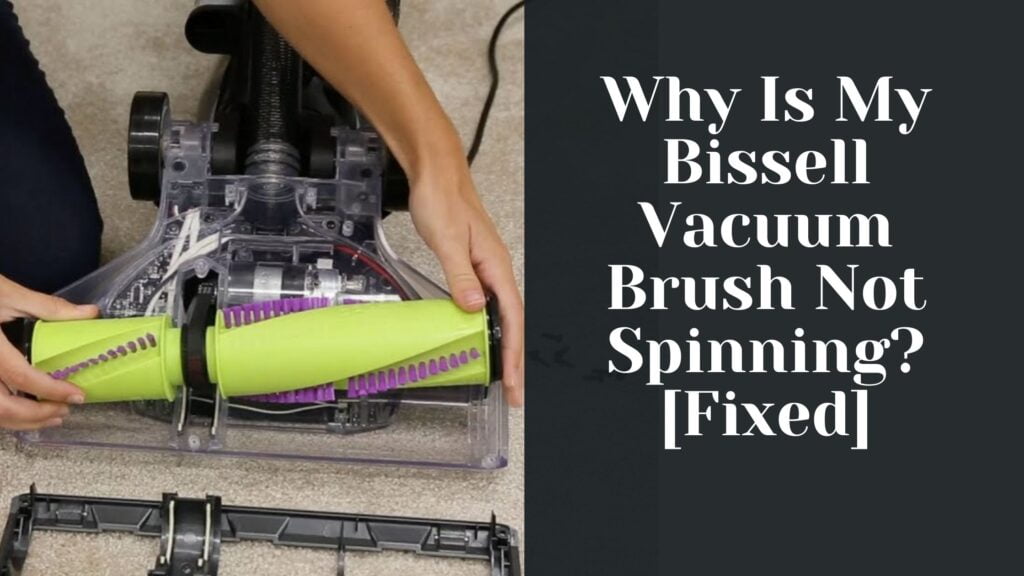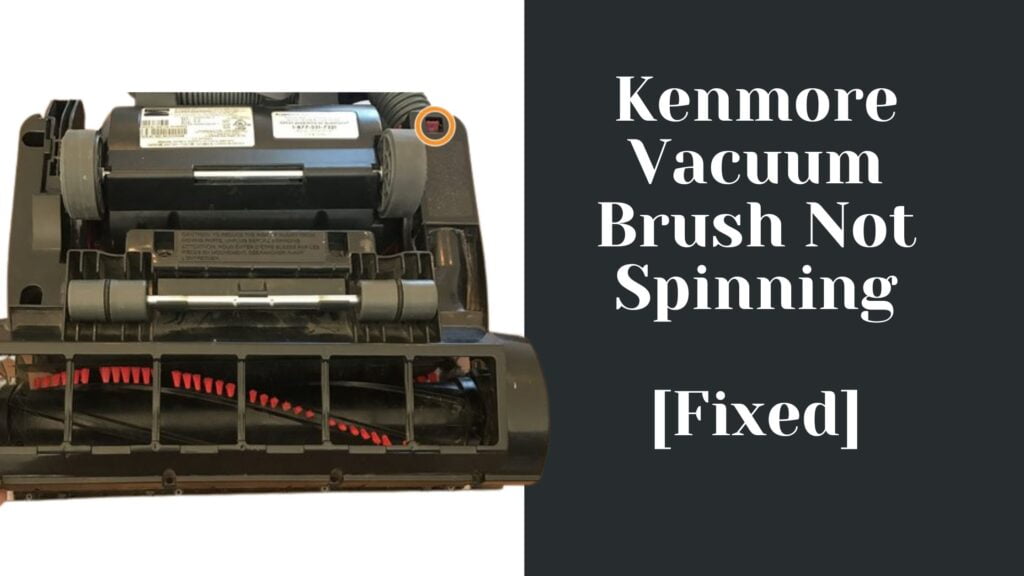When you’ve got a pet in your house, especially one as lovable and furry as a dog, it’s not uncommon to find their hair all over the place. Dog hair can be incredibly stubborn and tricky to clean up. If you’re struggling with your Bissell vacuum not picking up dog hair, don’t worry – you’re definitely not alone.
A lot of factors could be at play here. It could be an issue with the vacuum itself or perhaps some small but crucial error in how you’re using it. Sometimes, even the type of dog hair can make a difference! But rest assured that there’s always a solution to get your floors looking spotless again.
In this article, we’ll delve into why your Bissell vacuum might be failing to pick up dog hair and provide practical advice on what you can do about it. With a bit of patience and know-how, we guarantee that those pesky hairs won’t stand a chance!
Understanding the Issue: Bissell Vacuum Not Picking Up Dog Hair
When you’re encountering issues with your Bissell vacuum not picking up dog hair, it’s essential to understand the potential causes. There could be a myriad of factors at play, and knowing what they are can help you address the problem effectively.
Firstly, consider the type of floor you’re dealing with. Different flooring materials require different suction power levels. If your vacuum isn’t designed for your specific floor type or if it’s set to an incorrect setting, it might struggle to pick up dog hair efficiently.
Secondly, check if your vacuum’s filters and brushes are clean. Over time, these components can get clogged with dust and pet hair. This buildup can significantly reduce your vacuum’s effectiveness in picking up dog hair. Remember that maintaining regular cleaning schedules for these parts is crucial to ensure optimal performance.
Thirdly, take a look at the height adjustment settings on your Bissell vacuum cleaner. You’ll often find that adjusting this setting based on your floor type and the amount of pet hair present can make a substantial difference in how much pet hair gets picked up.
Lastly but importantly, don’t overlook blockages within the hose or other parts of the machine itself. These obstructions can reduce suction power drastically which hinders its ability to pick up any debris including dog hairs.
As each situation varies greatly from one household to another due to variables like number of pets, their breeds (long-haired vs short-haired), frequency of shedding etc., a one-size-fits-all solution doesn’t exist when it comes to vacuums not picking up dog hairs effectively. However by keeping these tips in mind when troubleshooting your Bissell vacuum cleaner issues related to picking up pet hairs should help improve its overall efficiency.
Common Causes for Your Bissell Vacuum’s Decreased Performance
There’s nothing quite as frustrating as a vacuum that isn’t doing its job, especially when faced with stubborn dog hair. If your Bissell vacuum isn’t picking up dog hair like it used to, there could be several reasons why. Let’s dive into some of the most common causes.
You might not think about it often, but the condition of your vacuum’s brush roll can dramatically impact its performance. Over time, strands of dog hair can wrap tightly around the roll, inhibiting its rotation and making it less effective at picking up new debris. This is especially true if you have long-haired breeds at home.
Next on our list is a dirty or clogged filter. The purpose of these components is to trap dust and small particles while allowing air to pass through. When they’re bogged down with grime, airflow becomes restricted which can significantly reduce suction power – the key element for lifting stubborn pet hair off your carpets and upholstery.
It may seem obvious but check that your vacuum bag or bin isn’t full. An overflowing collection container will affect suction efficiency and won’t leave room for any additional dirt or debris to be picked up.
Lastly, consider the possibility that you’re using an incorrect setting for your carpet height or floor type. Most vacuums offer different settings designed specifically for different surfaces: high-pile carpeting needs a different approach than bare hardwood floors or low-pile rugs.
Here are some points in summary:
- Check the condition of the brush roll – excessive pet hair may inhibit rotation.
- Inspect filters regularly – a dirty filter restricts airflow.
- Empty collection containers frequently – overfilling reduces suction power.
- Use appropriate settings – match them according to your floor type and height.
Remember, regular maintenance goes a long way in ensuring optimal performance from your Bissell vacuum cleaner!
Inspection of Bissell Vacuum Components
We’re about to take a deep dive into your Bissell vacuum. It’s crucial to understand what could be going wrong when it’s not picking up dog hair as expected.
Perhaps you’ve noticed something odd, but can’t quite pinpoint the problem? Let’s start by inspecting the primary components that could potentially cause this issue.
Firstly, take a look at the vacuum brush roll. It might surprise you how often this part is overlooked while troubleshooting. A tangled or worn-out brush roll won’t be able to pick up dog hair effectively. You see, it’s responsible for agitating and loosening debris from your carpet fibers, which includes stubborn pet hair.
Next on our checklist is the vacuum filter. Over time, dust and grime can accumulate in the filter causing blockage and consequently reducing suction power. Without adequate suction, even small particles like dog hair can prove challenging to vacuum up.
Then there’s the dirt container itself – if it’s brimming with debris, there’s simply no room for more! A quick emptying session might just solve your problem here.
The last piece of our inspection puzzle includes checking out those pesky hoses and attachments. They’re prone to clogs that may not be visible from outside but can hugely impact performance.
Don’t let these problems get you down – most are easy fixes that don’t require any technical expertise:
- Detangle or replace a problematic brush roll
- Clean or replace a clogged filter
- Empty an overflowing dirt container
- Clear out any blockages in hoses or attachments
Remember: regular maintenance is key in keeping your vacuum at peak performance level so it can tackle those pesky pet hairs without missing a beat.
Guide to Cleaning and Maintaining Your Bissell Vacuum Filters
Did you know that a poorly maintained vacuum filter could be the reason your Bissell isn’t picking up dog hair as it should? Let’s dive into how you can clean and maintain your Bissell vacuum filters to keep your machine running smoothly.
First thing’s first, let’s talk about timing. It’s recommended that you clean your filters every 3-6 months depending on usage. However, if you have pets or use your vacuum frequently, consider cleaning those filters monthly. This regular maintenance will ensure optimal performance from your vacuum cleaner.
Now for the actual cleaning process:
- Start by turning off and unplugging the machine.
- Remove the dirt tank from the base of the device.
- Twist and remove the separator from inside the dirt tank.
The foam filter is located underneath this separator and can simply be pulled out for cleaning. Rinse this under warm water until it runs clear, then leave it to air dry for at least 24 hours before reinstalling.
Next up is dealing with clogs in your vacuum:
- Check hoses regularly for blockages
- Empty dirt tanks after each use to prevent buildup
Maintaining these simple steps can make a world of difference in performance! If you’re still experiencing issues with dog hair pickup after following these steps, it may be time to replace your filters completely or consult with a professional repair service. Remember – keeping a clean filter not only improves efficiency but also extends the lifespan of your Bissell Vacuum!
Remember: don’t rush back into using your appliance before everything has thoroughly dried; moisture trapped inside could lead to mold growth or damage internal components.
What about replacement parts? Well, generally speaking, replacing disposable filters should occur annually while reusable ones need replacing every three years or so. But do take note: specific models might require different replacement schedules so always check user manuals just in case!
How to Unclog a Bissell Vacuum Hose Effectively
So, your beloved Bissell vacuum isn’t picking up dog hair like it used to, and you’ve got a suspicion that the hose might be clogged? No worries! Let’s dive into how you can unclog your vacuum’s hose effectively.
Firstly, always remember SAFETY FIRST. Unplug your Bissell vacuum from the power source before starting any maintenance work. You wouldn’t want to risk an electrical shock while trying to clean out that stubborn clog!
Now let’s get down to business. Start by detaching the hose from the vacuum body – most models allow for this with ease. Once removed, visually inspect the hose for blockages. If you spot one, try using a straightened wire hanger or broom handle (depending on the size of your hose) gently push it through.
Here are some tips:
- Be careful not to damage the interior of the hose.
- Don’t force anything if there’s resistance – you could compact the clog further!
- If pushing doesn’t work, try suctioning it out with another vacuum if available.
In case visual inspection doesn’t reveal anything but performance remains inadequate, don’t despair! It could just mean that our culprit is hiding deeper within or is too small to see clearly.
For such cases:
- Try filling half of your sink with warm water and adding mild detergent.
- Submerge your detached hose in this solution and swish around gently.
- Leave it soaked for about 15 minutes then rinse thoroughly with lukewarm water.
- Make sure to dry completely before reattaching back onto your Bissell vacuum.
With these steps, chances are high that whatever was obstructing airflow in your Bissell vacuum hose has been dislodged or washed away.
Remember: Regular maintenance goes a long way in preventing future clogs and keeping your machine at peak performance levels longer! So make time for routine checks on all parts of your appliance – not just when something seems amiss!
That said, we hope these instructions have helped you restore optimal function back into yours truly – The trusty Bissell Vacuum Cleaner!
Tips for Properly Cleaning the Brush Roll
Getting a Bissell vacuum to pick up dog hair can be tricky, but it’s not impossible. One of the most critical steps is ensuring your brush roll is squeaky clean. Let’s dive into some tips on how to do just that.
First off, you’ll need to remove the brush roll from your vacuum. It may seem daunting, but it’s simpler than you’d think. Most models have an easy-to-access compartment where the roller resides. A few screws are usually all that stand between you and a cleaner home.
Once you’ve got the brush roll in hand, it’s time to get down and dirty with cleaning it. And by “dirty”, we mean dealing with all that tangled-up dog hair! A pair of scissors or a seam ripper works wonders here – just carefully cut through and remove any entangled hairs.
Next up is giving your cleaned-up brush roll a good rinse under warm water. Ensure there isn’t any soap residue left behind as this could potentially damage your machine when reinstalled.
And finally, don’t rush back to put that roller in place right after washing it! It needs some time alone – let it air dry completely before putting it back into its rightful spot in your vacuum cleaner.
Remember, consistency is key when maintaining any device including vacuums; so make sure you’re regularly checking and cleaning out that brush roll for optimal performance.
Recommendations for Routine Maintenance of Bissell Vacuums
Keeping your Bissell vacuum in top shape isn’t rocket science. With regular maintenance, you’ll find that this versatile cleaner can tackle dog hair with ease. Let’s dive into some pro tips to keep your machine running smoothly.
First things first, always empty the dirt bin after each use. It’s a simple step but it makes a world of difference in maintaining suction power. If the bin is overfilled, your vacuum won’t pick up as much debris – and that includes dog hair. So make sure to empty it out regularly.
Next on the list: filters! Your Bissell vacuum likely has multiple filters that need cleaning or replacing periodically. Check your user manual for specifics, but generally speaking:
- The pre-motor filter should be cleaned every 3-6 months.
- Post-motor filters must be replaced every 6-12 months.
You might want to mark these dates on your calendar so you don’t forget!
Moving onto brush rolls – these are especially important when dealing with pet hair. Brush rolls can get tangled with fur over time, reducing their effectiveness drastically. Try removing any visible hair or debris from the roll after each use; if tangles persist, you may need to replace the roll altogether.
Last but definitely not least: check for blockages in hoses and attachments frequently! Even small obstructions can seriously impact suction power and leave more pet hair around than you’d like.
By following these routine maintenance steps:
- Emptying the dirt bin
- Cleaning/replacing filters
- Checking brush roll
- Inspecting for blockages
You’ll ensure that your Bissell vacuum stays ready to take on even the toughest of pet messes!
Conclusion: Keeping Your Bissell Vacuum Performing Optimally
So, you’ve been struggling with your Bissell vacuum not picking up dog hair. You’re probably frustrated and even considering a new purchase. But hold on! With some simple steps, you can get your appliance back to its optimal performance.
Firstly, be sure to clean your vacuum regularly. This doesn’t just mean emptying the dust bin after every use – it’s also important to check for blockages in the hose or brush roll regularly. You’ll be amazed at how much of a difference this makes.
Secondly, remember that filters need attention too. They should be cleaned or replaced according to the manufacturer’s instructions. If they’re clogged with dirt and debris, they won’t function efficiently which could lead to less suction.
Thirdly, don’t overlook the belt condition. A worn-out belt will affect your vacuum’s ability to pick up pet hair effectively.
Lastly but importantly is maintenance checks on seals and gaskets for any wear and tear which might reduce suction power over time.
By following these tips:
- Regular cleaning
- Filter maintenance
- Checking belts
- Inspecting seals and gaskets
You can keep your Bissell vacuum performing optimally for longer periods of time without investing in a new one right away.
Less frustration with dog hair cleanup means more time enjoying those furry friends we love so much!
Remember that vacuums are like any other tool; with proper care and routine upkeep, they’ll serve you well for years to come.





















